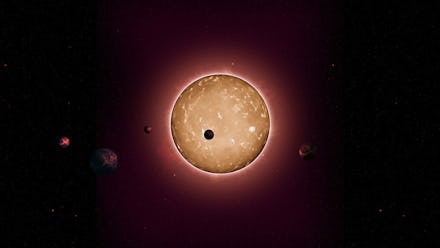Astronomers Just Discovered the Most Ancient Solar System in Our Galaxy

At 4.5 billion years old, the solar system you know is practically a baby compared to what astronomers just discovered in the depths of space.
A group of international astronomers announced Tuesday they've discovered the oldest planetary system in the Milky Way. At the ripe old age of 11.2 billion years, the formation consists of an ancient star and five Earth-like planets that date back to the dawn of the galaxy.
The research, first published in Astrophysical Journal, proves to scientists that similarly sized rocky planets could and did form when the galaxy was in its infancy, and lends support to theories about ancient life in our universe.
"It hints that old system planets are possible," said Sarbani Basu, an author of the paper per the Los Angeles Times. "And if those planets are in the habitable zone, then it is possible we could have old life too."
Old, indeed. Since the age of the entire universe is believed to be 13.8 billion years, this discovery is the oldest star with Earth-sized planets known to science.
The planets in the newly-discovered system are slightly smaller than Earth, with the largest as big as Venus and the smallest one similar in size to Mercury. They orbit a star known as Kepler-444, which is about 75% as big as our sun and located 117 light years away from Earth. The five planets take 10 days to orbit the star.
The scientists sifted through more than four years of NASA spacecraft data to make the discovery. The multinational team included astronomers from the United States, Europe and Australia.
Why it matters. Knowledge of other solar systems helps astronomers learn about more about what surrounds us. Steven Kawaler, an author on the paper, said it will also help them learn about the formation of the Milky Way.
"This is one of the oldest systems in the galaxy," Kawaler told the Iowa State University news service. "Kepler-444 came from the first generation of stars. This system tells us that planets were forming around stars nearly 7 billion years before our own solar system."
Daniel Huber, an Australian member of the team, noted in a statement how incredible this finding was.
"We've never seen anything like this — it is such an old star and the large number of small planets make it very special," Huber said. "It is extraordinary that such an ancient system of terrestrial-sized planets formed when the universe was just starting out, at a fifth its current age."
Now we only can wonder what else is out there.